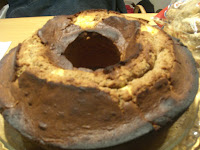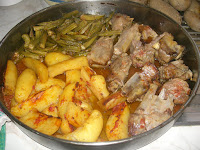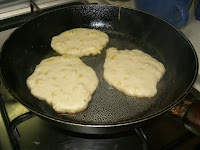
On our recent trip to London, we went to town food-wise. The previous year, we cooked some meals at my cousin's home to save money, and also because we visited at a time when it got dark very early and it was bitterly cold - most days averaged around 5 degrees Celsius, highly unsuitable temperatures for my two kindergarten children. But this year, as we were staying in a hotel, it was clearly not feasible to be preparing our own meals. Besides, my children were now at primary school, so they were easier to deal with. So we would take a picnic lunch on some days on our daily excursions (or buy takeaways when our Cretan mizithra and paximadi ran out!), and on most nights, we would eat out. On our first night, P led us to the famous (if slightly infamous) Wong Kei on Wardour St in Chinatown, the rudest China diner in London. We were lucky to find a table on our own (most people were sharing tables wherever there was a free seat). The most memorable dish was the crispy fried duck, cut and boned with a spoon(!) and the thin eggy pancakes. Apart from noodles, Aristotle and Christine ate 'souvlaki'; that's what the crispy fried duck in a pancake resembled! I must congratulate them on their relaxed attitude to foreign food. They have a more mature outlook concerning international cuisine than most Greek children their age.

On Sunday night, P wanted to meet up with us in Brick Lane, so after leaving Platform 9 and 3/4s at Kings Cross, we passed by the Ten Bells pub (aka Jack the Ripper's haunt), and ate at Preem. We ordered some curry dishes, which resembled saucy Greek meat casseroles and stews, the main difference being the hot and spicy additions. No wonder Indian people are overweight like the Greeks; I do believe that there must be such a thing as Indo-European cuisine, not just languages! Coincidentally, we had eaten exactly across the road from this place last year at a restaurant called Shampan; the meal there differed very little from the one we ate this time round.

On Monday, we ate the leftovers of yesterday's restaurant meal (all packed up for us in a doggy bag) at a park near the Imperial War Museum. The long weekend had tired us out, so we didn't want to go out that night. Our hotel was just round the corner from Earls Court underground station, where there is a plethora of fast food restaurants. The children chose Burger King; they also asked us why there was a man lying on the ground in a sleeping bag outside the premises, so we had to find a way to introduce so sensitive a topic to them such as homeless people. We bought burgers and chips; not exactly healthy, but the kids loved it. We also ate breakfast there once as we did not get up early enough to have it at the hotel, and I swear the coffee tasted like murky water.

On Tuesday, we waited for P at Shoreditch, and went to Whitechapel to a restaurant called Lahore. The staff made our children feel very welcome, and they even had a TV blaring loudly - there was a major soccer match being televised on the night we went. Some of the diners looked as though they couldn't have cared less about the food, as much as they cared for drinking alcohol while watching a televised sports of event of a national sport. Aside from the kitsch, this was Pakistani cuisine at its best. We started off the meal with a mango lassi, and went on to eat the most succulent BBQ lambchops I have ever tasted in my life, spiced up in South Asian style. We were also able to view a tandoori oven close up; the naan bread was heated up in it, simply by being stuck to the side of this oven!

On Wednesday, I had the clever idea to stay at the hotel and prepare a meal in the kitchen because we were due for a long trip out to Cambridge the next day, and I wanted to be fully prepared for it and have an early night in to get up very early the next day to catch tubes, trains and buses to Duxford Air Museum. I regret not going out instead, as our dinner that night consisted of canned giant beans and meatballs in tomato sauce, which I'd carried in our suitcase in readiness for a cheap night in at the hotel. I can now understand why people might go off Greek food; at least they weren't
baked beans! But never again - in London you can eat anything you want at the price you want.

On Thursday, after a very long but interesting day-trip out of London, I decided that we would not have time to eat out or even buy takeaways, as our train left from Cambridge at 7pm, and arrived at Kings Cross at 8pm, after which we had to make our way to Earls Court by tube. So we did what I suspect most London commuters do when they're too tired and bothered to prepare a meal after a long working day: before we boarded the train at Cambridge, we popped into the Marks and Spencers Simply Food outlet at Cambridge station and bought ourselves a variety of sandwiches, a salad, some corncobs, two tropical fruit juices, some carrot sticks in a dip, a couple of packs of crisps and a dessert. My husband's idea to eat once we got home was tossed out the (train) window when we saw what our fellow ommuters were doing; we tucked into our meal, and my most memorable part of that journey was watching my very tired children eating as if they had never seen food before. They scoffed the lot. In fact, they were so well revived by the meal that they didn't feel sleepy when we reached the hotel, despite having been on the road since 7am, and spending over six hours walking around a huge open-air museum. We could have gone out for walkies at this point, save the fact that we were in our PJs!

On Friday, it was pissing with rain, so we decided that we would have to visit a museum, where we would stay till closing time, and then meet up with P. We ended up eating a rather early lunch close to St Pauls' in the City at a cafe called Piccolo's, a place which served lots of ploughman's lunches for burly construction site workers, as well as more refined meals like chili con carne and curried chicken. Quite a few businessmen also had lunch or coffee there, while they were constantly on their cellphones. The food there was very hearty, and I liked its light taste. It filled you up and it wasn't too oily. The dining room area was the most intriguing part of the visit. It reminded me of Charles Dickens' Christmas story; with its red brick-built walls, it looked like an underground sewer that had been drained and turned into a dining room. The roof was covered in brick arches, and in one corner, there was a disused fireplace. All that was missing was a poor Victorian family huddling around it. I could imagine a family of wretches living there in the 1850s; either that, or it could have been the kitchen area where the cook would prepare meals downstairs, then put it in the hatch (there was one above the fireplace) and ring the bell for the servants to pick up upstairs and serve it to the lady and the lord who lived there. There were no windows, so whoever lived or worked there could never see the sun, or get any fresh air. Spooky if you have never seen this sort of place before. The waitree, interestingly enough, was Portuguese. Being a bold traveller, I asked her about how she ended up in London, and what her future plans were. She opened her heart out to us; I suppose she didn't often see families coming in to this diner and she could relate to us as fellow Mediterraneans. She had left Portugal with her husband because of the high unemployment they both faced there. They were both working in various jobs, trying to save as much money as they could in order to go back home for good one day. She had gotten very depressed lately, because of the high cost of living in an overcrowded city with a bad housing situation - she and her husband lived in a tiny one-bedroom apartment, which cost them most of her own pay from working at the diner. She couldn't even think of having children becuase of the expenses and the lost income. She also complained about the food; Portuguese specialties were not easy to obtain of course, and when they were available, they were quite costly. She told me she didn't know how long she would be able to endure London life, and being away from her family. I felt sorry for her. She reminded me of my parents who left their villages in Crete because they were poor and knew that they had no prospects of self-improvement in their own homeland. My own success in this globalised world is due in part to their sacrifices.

On Saturday, after another long day-trip (how we managed to visit both Kew Gardens and Hampton Court Palace in one day, and then stroll right along the South Bank from London Eye past Waterloo Bridge and back, together with two toddlers, only I will ever know), we felt like a quick pizza meal. We wanted to eat in, and we actually managed to find a pizza chain - Perfect Pizza in South Kensington - that served up mainly deliveries and takeaways, but it also had two (just two) tables with five stools (in total) if anyone felt like eating in. Talk about cramped for space! We ordered the works: a pizza, coleslaw, baked potatoes and fried chicken wings. Good value stodge, washed down with fizzy drink. My husband said he'd neved eaten such good pizza before. I tend to view all junk food as junk, so I couldn't see his point.

On Sunday, after a beautiful day out, walking around the camden Town markets and sampling all sorts of international food-stalls by the canal where we ate Argentinian, Carribean, Chinese, Indian and English (if there is such a thing) food, we went for a walk to Hampstead Heath, where we climbed up to Parliament Hill and got a birdseye view of Lodon. After that, we went to Wetherspoons in Finchley Road at the O2 Centre, for a taste of pub atmosphere. This pub chain is well known for being kid-friendly, which upmarket London restaurants are, unfortunately, generally not. I'm not one for roast meat dinners, but I was in for a treat when I ordered steak and kidney pie. I hadn't had one of those in ages, and it tasted just like the steak and kidney pies we used to eat in New Zealand; I loved it.

On Monday, we found ourselves inundated by tourist traps. We wanted to eat at South Kensington at Bella Italia where we had had a super meal on our last visit there, only to find it closed. So we headed off to White City - it seemed logical to take the tube and stop off wherever we knew a lot of people were heading to - close to the BBC buildings, but the food there seemed wholly unappetising. We then took the tube to High Street Kensington, where we felt like fish out of water because we didn't know the area very well. When you can't avoid eating junk, you may as well eat safely in a well-known pizza or burger bar. We chose Pizza Hut, where we ordered very little, but at the end of the meal, we felt like stuffed potatoes - that's what fake food does to your stomach. The kids loved it.
On Tuesday, sadly, it was time to say goodbye. Our last meal was a Chinese buffet lunch at the China Red restaurant, again in the O2 Centre on Finchley Road. That place seemed to epitomise London life for me; long busy roads full of shops, and red double-decker buses constantly coming and going. I bought some raspberries from a stall vendor who spoke in that alluring Cockney accent which we find so irresistable; he had balckened teeth to match it. Another example of Victoriana! He was surprised when I told him I was taking this fruit on the plane. He simply melted when he heard we were from Greece, and told us how lucky we were to live in a sunny place. Would you ever move there, I asked him, like many Brits who are making their home on our island? If I could, he said, I'd be out of this place as fast as possible! Why, I asked him, what is it that you don't like about it? London's changed, he said, it's all drugs and knives and crime now, he said. It's hard to explain this sort of thing to my husband; he is only now beginning to realise that the London we saw was only the small part that is well-policed.
I can't find a photo of China Red on the internet; has it closed down since we were last there? My husband was very impressed with the wide variety of dishes that were on offer. Being familiar with the worst kind of food from this internationally renowned cuisine, I felt it was a sad conclusion to an otherwise fabulous round of the finest cuisine London had to offer.
©All Rights Reserved/Organically cooked. No part of this blog may be reproduced and/or copied by any means without prior consent from Maria Verivaki.
MORE REVIEWS:
Akrogiali
Anemomilos
Aroma
Agora
Paleohora cuisine

 Talking about milkshakes, why not try the lassi version instead? The Indian lassi drink is very popular these days. It's so much more trendy to say you're having a lassi than a milkshake. But it's the same thing, really, it's a milk-based shake. We've all heard of mango lassi. It was invented in a third world country, it is not a technology-based food item, and mango was the first fruit to be associated with it. But let's face it, we don't all live in countries where mangos are widely grown. Our mango tree produced just two this year, so I couldn't expect to make mango lassi the whole summer long. So why not try making lassi - or smoothie, call it what you like - with any readily avaialble fruit with a thick consistency similar to that of mango? A cheap and common alternative, despite its undesirably high level of carbon footprints required to get it to our fruit baskets, is the humble banana. I had a couple of over-ripe bananas in the house, the type that grow black spots on their skin, despite having no blemishes in their flesh. Beauty is only skin deep, but my children are too young to understand that, whereas my husband is too childish to believe it; he also scoffs at black-spotted bananas. Here's what I made with one. I did use a blender, because it makes life easier. But if the banana is really ripe, you can mash it up using a fork (I suppose).
Talking about milkshakes, why not try the lassi version instead? The Indian lassi drink is very popular these days. It's so much more trendy to say you're having a lassi than a milkshake. But it's the same thing, really, it's a milk-based shake. We've all heard of mango lassi. It was invented in a third world country, it is not a technology-based food item, and mango was the first fruit to be associated with it. But let's face it, we don't all live in countries where mangos are widely grown. Our mango tree produced just two this year, so I couldn't expect to make mango lassi the whole summer long. So why not try making lassi - or smoothie, call it what you like - with any readily avaialble fruit with a thick consistency similar to that of mango? A cheap and common alternative, despite its undesirably high level of carbon footprints required to get it to our fruit baskets, is the humble banana. I had a couple of over-ripe bananas in the house, the type that grow black spots on their skin, despite having no blemishes in their flesh. Beauty is only skin deep, but my children are too young to understand that, whereas my husband is too childish to believe it; he also scoffs at black-spotted bananas. Here's what I made with one. I did use a blender, because it makes life easier. But if the banana is really ripe, you can mash it up using a fork (I suppose).











































